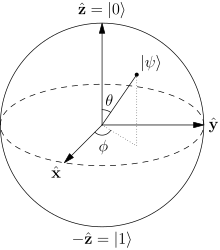Qutrit
A qutrit (or quantum trit) is a unit of quantum information that is realized by a quantum system described by a superposition of three mutually orthogonal quantum states.[1]
The qutrit is analogous to the classical base-3 trit, just as the qubit, a quantum system described by a superposition of two orthogonal states, is analogous to the classical base-2 bit.
Representation
A qutrit has three orthonormal basis states or vectors, often denoted , , and in Dirac or bra–ket notation. These are used to describe the qutrit as a superposition state vector in the form of a linear combination of the three orthonormal basis states:
- ,
where the coefficients are complex probability amplitudes, such that the sum of their squares is unity (normalization):
The qubit's orthonormal basis states span the two-dimensional complex Hilbert space , corresponding to spin-up and spin-down of a spin-1/2 particle. Qutrits require a Hilbert space of higher dimension, namely the three-dimensional spanned by the qutrit's basis ,[2] which can be realized by a three-level quantum system. However, not all three-level quantum systems are qutrits.[3]
A string of n qutrits represents 3n different states simultaneously, i.e., a superposition state vector in 3n-dimensional complex Hilbert space.[4]
Qutrits have several peculiar features when used for storing quantum information. For example, they are more robust to decoherence under certain environmental interactions.[5] In reality, manipulating qutrits directly might be tricky, and one way to do that is by using an entanglement with a qubit.[6]
See also
- Radix economy
- Mutually unbiased bases
- Quantum computing
- Ternary computing
References
- Nisbet-Jones, Peter B. R.; Dilley, Jerome; Holleczek, Annemarie; Barter, Oliver; Kuhn, Axel (2013). "Photonic qubits, qutrits and ququads accurately prepared and delivered on demand". New Journal of Physics. 15 (5): 053007. arXiv:1203.5614. Bibcode:2013NJPh...15e3007N. doi:10.1088/1367-2630/15/5/053007. ISSN 1367-2630.
- Byrd, Mark (1998). "Differential geometry on SU(3) with applications to three state systems". Journal of Mathematical Physics. 39 (11): 6125–6136. arXiv:math-ph/9807032. doi:10.1063/1.532618. ISSN 0022-2488.
- "Quantum systems: three-level vs qutrit". Physics Stack Exchange. Retrieved 2018-07-25.
- Caves, Carlton M.; Milburn, Gerard J. (2000). "Qutrit entanglement". Optics Communications. 179 (1–6): 439–446. arXiv:quant-ph/9910001. doi:10.1016/s0030-4018(99)00693-8. ISSN 0030-4018.
- Melikidze, A.; Dobrovitski, V. V.; De Raedt, H. A.; Katsnelson, M. I.; Harmon, B. N. (2004). "Parity effects in spin decoherence". Physical Review B. 70 (1): 014435. arXiv:quant-ph/0212097. Bibcode:2004PhRvB..70a4435M. doi:10.1103/PhysRevB.70.014435.
- B. P. Lanyon,1 T. J. Weinhold, N. K. Langford, J. L. O'Brien, K. J. Resch, A. Gilchrist, and A. G. White, Manipulating Biphotonic Qutrits, Phys. Rev. Lett. 100, 060504 (2008) (link)
External links
- Physicists Demonstrate Qubit-Qutrit Entanglement by Lisa Zyga at Physorg.com, February 26, 2008 . Accessed March 2008
- qudit—Wiktionary.
